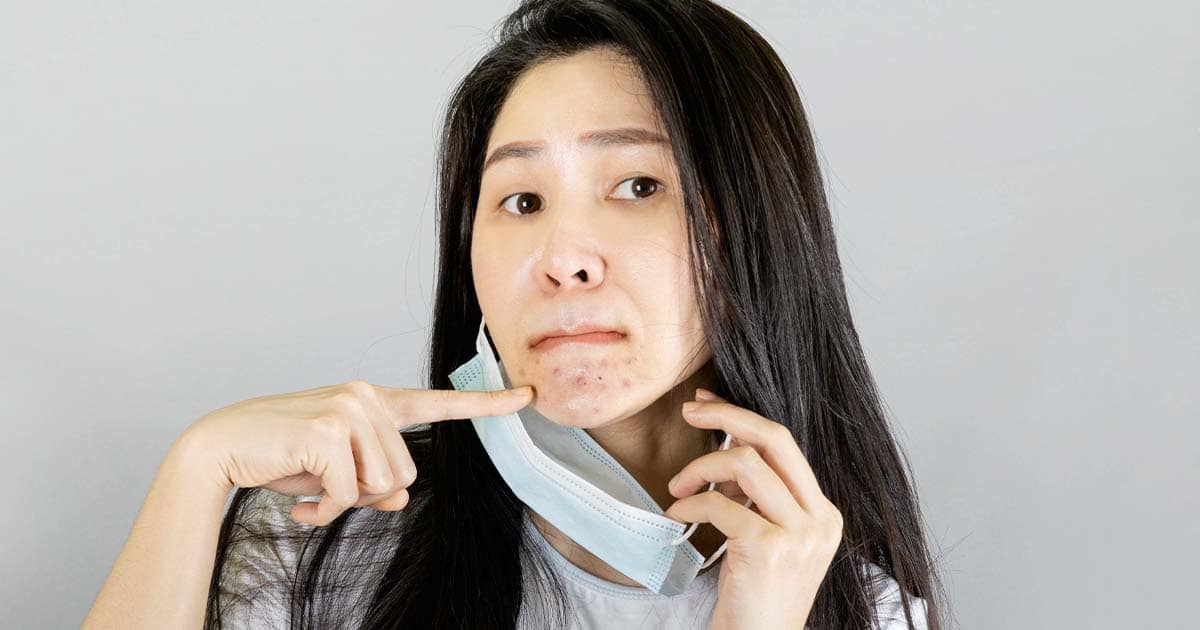
04
Nov
Maskne is the New Acne
2020 has been a challenging year for all of us. Adjusting to life during the pandemic has required us to adapt and evolve in a lot of ways – some of which have been very unexpected.
One major adjustment we’ve all had to get used to is the dreaded face mask. When we started wearing facial protection earlier in the year, most of us probably hadn’t anticipated that it would come with a rather unfortunate and frankly annoying side-effect: acne, commonly referred to as Maskne. As if a highly infectious disease wasn’t hard enough to deal with!
Maskne is real!
Although it may seem like a new phenomenon, mask-related acne or Maskne isn’t at all new or made-up. Most medical workers required to wear surgical masks have had to deal with this exact issue in the past.
Now, with the general population required to wear face masks in public, Maskne has become a widespread problem, so much so that the American Association of Dermatology (AAD) has begun to advise people on how to combat it. Many people have contacted their dermatologists regarding breakouts to the point where it’s become a mini-epidemic of its own.
So, if you’ve been having acne flare-ups recently, it could very well be the doing of your mask.
How does a mask cause acne?
Ironically, the very thing that keeps us from transmitting COVID-19 is also what causes Maskne. When you breathe, cough, or sneeze, the droplets that escape your mouth and nose are trapped by the mask. That’s good for curbing the spread of the Coronavirus, but not ideal from a skincare point of view. Your mask traps warm air, saliva, sweat, sebum, and bacteria, thereby creating a humid environment that can cause a variety of skin related problems.
The most common of these is Acne Mechanica, which is the result of excessive heat, friction, or occlusion on the skin. Coupled with the moist environment that a mask creates, you’re looking at a breeding ground for pimples and acne due to your pores getting clogged. The skin also becomes dry and itchy. This is also why some athletes suffer from acne; the prolonged use of protective facial gear leads to irritation of the skin that often results in a breakout

Other mask-related skin conditions
Aside from Acne Mechanica, many people report a variety of other mask-related skin problems. Of, these the most common are:
-
Rosacea – Redness and bumps that are usually caused by heat
-
Perioral dermatitis – A scaly or bumpy rash that affects regions of the face (the mouth, cheeks, nose, or eyes)
-
Contact dermatitis – An inflammatory rash that’s flares-up due to an allergic reaction from one of the materials in the mask
How to prevent Maskne?
If you were looking for an excuse not to wear a face mask, then this isn’t it. For better or for worse, we’re stuck wearing masks until the pandemic is over. Fortunately, there are some great skincare tips you can start employing today to prevent a potential breakout.
Use a Quality Mask
There are dozens and dozens of worldwide manufacturers of 3-ply masks to choose from. Each has their own process, environment and specific materials used to create the mask. A ‘clean’ room from one company could have a different set of requirements and definitions elsewhere. Read the packaging and research the company and source from which the masks are being made.
Disposables mean they are meant to be disposed
Sometimes it is easy to just keep wearing your 3-play mask for multiple days. It looks clean right? No makeup smudged on it? Still keeping its form? WRONG. A disposable 3-play mask should be disposed after it is used. It is a single-use disposable mask, so while you may go through more than one a day, switching them out more often will help with reducing Maskne.
Wash your face
By now you’re probably accustomed to washing your hands before you leave the house and when you get back. Add washing your face to the mix if you want to prevent breakouts. Use a cleanser that’s non-comedogenic so as not to block your pores and ensure you do a thorough wash.
A little moisturizer goes a long way
Apply a light moisturizer before putting on your mask and after washing your face. Not only will this keep your skin hydrated, but it also prevents the skin from irritation by adding a protective layer. Be sure to use a moisturizer that’s right for your skin type to avoid complications. The AAD recommends Gel moisturizer for oily skin, lotion for normal skin, and cream for dry skin.
Go easy on the makeup
When wearing a mask, you shouldn’t do more than a bit of light makeup as it can irritate the skin and block your pores. Be sure to avoid harsh skincare products like retinol, benzoyl peroxide, or comedogenic products. If you’re wearing a mask that’s a tight fit, such as the N95 mask, you should skip wearing makeup altogether. The combination of makeup and sweat will be too much stress on your skin, leading to a breakout.
